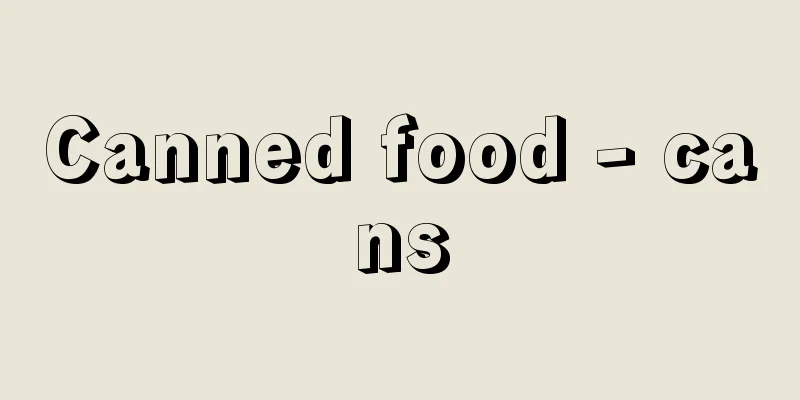Canned food - cans

|
This refers to food or dishes packed in a metal container such as tinplate or aluminum, sealed, and heat-sterilized to enable long-term storage. In a broad sense, bottled and retort foods are also included in the canned food category. Products that are packed in a can and sealed, but not heat-sterilized, such as powdered milk, confectionery, and cooking oil, are distinguished as canned and are not included in the canned food category. [Tomomi Kono and Yonago Yamaguchi] historyThe principle of canned food manufacturing was first devised by Nicolas Appert of France in 1804. Napoleon called for the invention of a long-term food supply for the army, and the Parisian confectioner Appert's method of food preservation, combining a sealed container and heat sterilization, won the prize, receiving a prize of 12,000 francs. Appert's research used bottles instead of cans, but later, in 1810, Peter Durand of England developed a sealed container using a tin can and obtained a patent. This was the beginning of so-called canned foods. Large-scale canned food production began in 1821 when a canning factory was built in Boston, USA. After that, with the mechanization of tin can manufacturing and improvements in sealing methods (from brazing to rolling), the industry was commercialized all over America, and it developed greatly, mainly in America. Even today, America is one of the major countries in the canned food industry. It was in 1873 that the French chemist Pasteur demonstrated the relationship between heat sterilization and the prevention of spoilage, thus providing scientific evidence for the principles of canning. The first canned foods in Japan were made in 1871 (Meiji 4) when Matsuda Masanori (1832-95) of Nagasaki, under the guidance of French teacher Léon Julie, made canned sardines in oil. In 1874, Yamada Minosuke, who learned the manufacturing method from American teacher Lyman, started canning vegetables. In 1875, the Naito Shinjuku branch office of the Agriculture Promotion Bureau (Tokyo) attempted to can fruit, but full-scale canning did not begin until around 1877, when the Hokkaido Development Commission opened a canning factory in Hokkaido and taught the manufacturing of canned salmon and trout. Demand for canned foods for the military increased significantly during the Sino-Japanese War (1894-95) and the Russo-Japanese War (1904-05), and they became an important military supply. This led to the development of flavored canned foods that could be eaten immediately. In addition to fish and shellfish, canned goods include beef, kelp, and Yamatoni. With the start of fishing in the Northern Kuril Islands in 1997, canned production of crab, salmon, and trout also began, and expanded further after the conclusion of the Japan-Russia Fisheries Agreement (1907) made it possible to catch fish off the coast of Kamchatka. Canned production of mandarin oranges, tuna, sardines, and other fish also became active, and became an important export industry as well as a source of domestic consumption. After World War II, production reached a level that already exceeded the prewar peak in 1955 (Showa 30). [Tomomi Kono and Yonago Yamaguchi] Manufacturing processThe manufacturing process for canned foods varies slightly depending on the type of ingredients, but the main steps are almost the same: ingredients → washing and cooking → weighing, stuffing and pouring liquid → degassing and sealing → sterilization, cooling and inspection → finished product. [Tomomi Kono and Yonago Yamaguchi] Cleaning and cookingThe ingredients used are fresh fish and shellfish, meat that has been aged to taste good, fruits that are ripe enough for processing, and vegetables that are the right size for the purpose of canning. For peaches, pears, apricots, asparagus, mushrooms, tomatoes, green peas, sweet corn, etc., the ripeness of fruits and the freshness of vegetables greatly affect the quality of canned goods. In particular, vegetables that are not very fresh are prone to giving off an unpleasant odor. After washing the ingredients, the head, tail, skin, bones, internal organs, and blood of fish are removed, the shells of shellfish are removed, and the skin, pod, seeds, and core of fruits and vegetables are removed, and then cut into sizes that are easy to pack into cans. The ingredients are then boiled or steamed. The purpose of this is to coagulate the proteins in fish and meat to prevent them from falling apart during canning, and to dissolve and remove unpleasant odors and excess fat depending on the type. In fruits and vegetables, it inactivates various oxidative enzymes and prevents changes in color, flavor, nutritional content, etc. [Tomomi Kono and Yonago Yamaguchi] Weighing meat filling and liquid injectionAfter pre-processing, the raw materials are packed into cans according to the standards for content (solid content and total content) and size. As most canned seafood is solid, it was previously packed by hand, but automatic meat stuffing machines have recently come into use. Liquid products are filled automatically. Next, the cans are weighed, and it is common to pack about 10% more meat than the standard. Salt water or seasoning (sugar syrup, soy sauce, salad oil, tomato puree, etc.) is then added. [Tomomi Kono and Yonago Yamaguchi] Degassing and sealingCans filled with the contents are degassed and sealed using a vacuum sealer to remove the air from inside the can. This, along with sterilization, is the most important process in canned food manufacturing. If oxygen or other substances remain inside the can, the product will deteriorate and spoil, so the purpose of this is to prevent this and to prevent air and bacteria from entering from the outside again, which results in the food's flavor and luster being maintained and it can be stored for a long time. Removing oxygen also prevents corrosion of the inside of the can. Cans are sealed using a double seaming technique. A can is made by fitting the cylindrical body and lid together and seaming the can, with a sealing compound (a packing made from natural rubber) applied to the underside of the rim of the lid. The first seaming involves folding the top end of the can body and the edge of the lid together using a roll, and then crimping them together using a second seaming roll. There are various types of double seaming machines, but vacuum seaming machines are commonly used. Double seamed cans are also called sanitary cans, a name derived from the fact that this method eliminates the lead hazard that occurs with soldered cans, an older can-making method. [Tomomi Kono and Yonago Yamaguchi] Sterilization, cooling, and inspectionAfter sealing, the can is sterilized by heating. This is to kill microorganisms such as bacteria, mold, and yeast, allowing for long-term storage. Sterilization is done in hot water or a pressure cooker. The temperature and time of heat sterilization vary depending on the type of contents and the size of the can. Fruits, tomatoes, and other acidic foods can be killed at temperatures below 100°C, so sterilization is done at a relatively low temperature. For highly acidic liquids such as fruit juice and tomato juice, the juice is sterilized at about 80°C beforehand, and then hot-filled at high temperature. In this case, the can is cooled immediately after filling and vacuum-sealing. For non-acidic foods such as non-acidic vegetables, fish and shellfish, and meat, heat-resistant bacterial spores tend to remain and cause the can to spoil. Therefore, to kill these spores, heat sterilization at a high temperature of 105 to 115°C for more than 30 minutes is required. After sterilization, the can is immediately cooled. If it is left at a high temperature, the quality will change and the inside of the can will corrode. Generally, the cans are cooled with water, but then they are thoroughly dried to prevent rust from forming. After sterilization and cooling, the cans are tapped with a metal rod to check the quality of the cans based on the sound and vibrations produced, and the cans are then boxed up to complete the production process. [Tomomi Kono and Yonago Yamaguchi] containerTinplate cans and aluminum cans are the main containers for canned foods. Tinplate is made by plating steel sheets with tin. Tinplate sheets for canning are generally 0.214 to 0.320 mm thick, but as steelmaking technology has advanced, thinner sheets have been produced. In addition, painted cans are generally used to prevent corrosion of the inside of the can and discoloration of the contents, except for canned fruit and fruit juice. The paint used depends on the type of contents, and synthetic resins are becoming more common these days. In particular, when crabs and other foods are canned, sulfur compounds in the protein generate hydrogen sulfide, which reacts with tin and iron to cause the contents to turn black. To prevent this, C enamel (special enamel for canned foods) is used, and phenol-based paints are used for fish and meat that contain a lot of fat, and vinyl-based paints are used for beer and carbonated drinks. Recently, composite paints that mix epoxy-based paints with these paints have also been used. Aluminum cans have also become more common. In this case, the purity of the aluminum must be extremely high. If the purity is low, it will corrode due to electrolytic action and develop holes. Many cans have a pull-top handle, with cuts made to make them easier to open, and the can is opened by pulling the handle. Cans made of steel plated with chrome or treated with chromate are also used for some foods. Bottled foods, which are filled with food, sealed, and sterilized, are also generally considered to be canned foods. Retort foods, which are bags made of aluminum foil laminated to plastic film and can be sterilized at high temperatures, have also been developed, and their production and consumption are rapidly increasing. In other countries, these are called flexible cans, and are sometimes included in the broad definition of canned foods. [Tomomi Kono and Yonago Yamaguchi] kindsA wide variety of canned foods are produced depending on the type of ingredients and processing method, but they can be broadly classified as follows: By raw material, there are fish and shellfish, meat, fruits, and vegetables, and by processing method, there are boiled, salted, seasoned, miso-pickled, grilled, teriyaki, oil-pickled, smoked oil-pickled, tomato-pickled, spice-pickled, etc. for fish and shellfish, pickled in syrup, boiled or seasoned for vegetables, boiled, seasoned, corned beef, etc. for meat. In addition to these, there are canned dishes made by combining various ingredients, soups, cooked rice, beer, sake, various beverages, dairy products, etc., and special-purpose products such as baby food, food for the sick, and pet food (dog and cat feed). [Tomomi Kono and Yonago Yamaguchi] How to read the can markThe can mark is engraved or printed on the lid. The labeling of Japanese canned foods is unique to Japan and varies from country to country. The expiration date used to be displayed in four digits, but in recent years, easy-to-understand six-digit labels have been adopted, and many products follow this labeling. Imported canned foods are only required to display the import date. In the case of Japanese canned foods, the labeling used to be in three rows of symbols. When the expiration date is displayed in four digits, the top row indicates the product name, the middle row indicates the factory name, and the bottom row indicates the expiration date. When the expiration date is displayed in six digits, the top row indicates the product name, the middle row indicates the expiration date, and the bottom row indicates the factory name. In the product name, the size is indicated with a symbol L (large), M (medium), S (small), or ● (broken), and the cooking method is indicated with a symbol such as N (boiled in water) or O (pickled in olive oil). Due to labeling systems such as the Quality Labeling Standards, detailed contents are now displayed on the body of the can, so recently many cans only display the expiration date. [Tomomi Kono and Yonago Yamaguchi] Preservation and nutritionCanned foods are sealed to remove all air and sterilized under a high vacuum, so some fruits and vegetables contain more vitamins and other nutrients than those cooked at home. Fish and other foods are sterilized under high pressure, so nutrients are often present in a form that is easily absorbed. Canned foods are also hygienic because they do not pose a risk of food poisoning or infectious diseases. Canned foods have lower intermediate costs than fresh foods, and since only the edible parts are included, the entire contents can be eaten, making them economical. Canned foods can be stored semi-permanently, but in terms of taste, the best-before period is about 3 to 4 years for sour foods and 4 to 5 years for other foods. Painted cans are widely used except for canned fruits and fruit juices, so the product value can be maintained for a long time. Canned fruits and fruit juices are especially made in unpainted cans to prevent changes in color and flavor. This is to prevent changes in quality due to the action of the slightly soluble tin, which dissolves the iron in the can, and to prevent pinholes from appearing in the can. [Tomomi Kono and Yonago Yamaguchi] UsageA normal can has a slight dent in the lid because it is vacuum sealed. On the other hand, if the contents are spoiled, gas will build up and the lid will swell. This is called an expanded can. Also, among dented cans, those with damaged seams should be avoided, as they may have small holes. The same goes for cans with rusty seams. The cans are labeled with the product name, ingredients, additives, weight, and the address and name of the manufacturer or distributor. For products that use mixed ingredients, the ingredients are listed in order of the amount, and for products that use pineapple rings, the number of pieces is listed. There are also restrictions on the name, with corned beef being limited to products that use only beef, and those that contain horse meat being called new corned meat or new corned meat. It is best to use up all the canned food as soon as you open it, but if you have any left over, transfer it to a separate container other than the can, such as a glass container, put the lid on, and store it in the refrigerator. In particular, if you leave cans containing acid, such as fruit, after opening them, a large amount of tin will dissolve rapidly, and in some cases, poisoning may occur. [Tomomi Kono and Yonago Yamaguchi] "A Visual History of Japanese Canned Foods" (1987), edited and published by the Japan Canned Foods Association; "Introduction to Canned Foods: Canned Foods, Bottled Foods, and Retort Foods," revised and expanded edition, by Kozaburo Hirano and Toshiaki Miura (1992, Japan Food Newspaper Co., Ltd.) ©Takashi Aoki Canned food manufacturing process (canned tuna in oil) Source: Shogakukan Encyclopedia Nipponica About Encyclopedia Nipponica Information | Legend |
|
ブリキまたはアルミなど金属性の容器に食品あるいは料理を詰めて密封し、加熱殺菌することで、長期間の保存を可能にした食品をいう。広義には瓶詰やレトルト食品も缶詰の仲間である。粉乳、菓子類、食用油などのように、缶に詰めて密封してあっても、加熱殺菌をしていないものは缶入りとして区別し、缶詰に含まない。 [河野友美・山口米子] 歴史缶詰の製造原理は、1804年フランスのニコラ・アペールによって初めて考案された。ナポレオンが長期保存のできる軍用食糧の発明を公募し、これに応募したパリの製菓業者アペールの密封容器と加熱殺菌を併用させた食品保存法が入賞、1万2000フランの賞金が与えられた。アペールの研究は缶ではなく瓶を用いたものであったが、その後、1810年にイギリスのピーター・デュランドPeter Durandがブリキ缶を用いた密封容器を開発し特許を得た。いわゆる缶詰canned foodsの始まりである。大規模な缶詰製造は、1821年アメリカのボストンに缶詰工場が建設されてからである。その後ブリキ缶製造の機械化、密封法の改良(ろう付け法→巻締め法)もあって、アメリカ各地で企業化が進み、アメリカを中心に大きく発展した。今日でも、アメリカは、缶詰工業の主要な国の一つである。なお、フランスの化学者パスツールが加熱殺菌と腐敗防止の関係を明らかにしたのは1873年のことであり、これによって缶詰の原理が科学的に裏づけされた。 日本の缶詰は1871年(明治4)に長崎の松田雅典(まさのり)(1832―95)がフランス人教師レオン・ジュリーの指導を受け、イワシの油漬け缶詰をつくったのが始りとされる。74年にはアメリカ人教師ライマンから製法を習った山田箕之助(みのすけ)が野菜缶詰をつくっている。75年には勧農局の内藤新宿出張所(東京)で果実缶詰の製造が試みられたが、本格的な製造開始は、77年ごろ開拓使が北海道に缶詰工場を開設して、サケ・マスの缶詰製造を伝習させて以来のことである。日清(にっしん)(1894~95)、日露戦争(1904~05)から、軍用食糧としての需要が大きく伸び、軍需品として重要な位置を占めた。そのため、そのまますぐに食べられる味つけ缶詰が発展した。魚貝類のほか、牛肉、昆布や大和煮(やまとに)などの缶詰がつくられている。97年北千島漁業の開始に伴って、カニやサケ・マスの缶詰製造が始められ、日露漁業協約締結(1907)でカムチャツカ沿岸の漁獲が可能となってからはさらに拡大された。また、ミカン、マグロ、イワシなどの缶詰製造も活発となり、国内消費とともに、重要な輸出産業となった。第二次世界大戦を経て、1955年(昭和30)に早くも戦前の最高生産量を上回る水準に達した。 [河野友美・山口米子] 製造工程缶詰の製造は、原料の種類によっていくらか工程が異なるが、主要な点はほとんど同じである。製造方法は、原料→洗浄・調理→秤量(ひょうりょう)肉詰め・注液→脱気・密封→殺菌・冷却・検査→製品の順で行われる。 [河野友美・山口米子] 洗浄・調理原料は、魚貝類は鮮度のよいもの、肉類は味よく熟成されたもの、果実は加工に適した熟度のもの、野菜は缶詰の目的にあった大きさのものを使う。モモ、洋ナシ、アンズ、アスパラガス、マッシュルーム、トマト、グリーンピース、スイートコーンなどは、果実では熟度、野菜では鮮度が缶詰の品質に大きく影響する。とくに野菜では、鮮度のよくないものを使用すると不快なにおいが出やすい。原料は洗浄を行ったのち、魚類では頭部・尾部・皮・骨・内臓・血液などを、貝類では殻を、果実・野菜では果皮・莢(さや)・種子・芯(しん)部などを除き、缶に詰めやすい大きさに切断する。次に湯煮(ゆに)または蒸し煮を行う。その目的は、魚類・肉類では、タンパク質を凝固させて缶詰時の身くずれを防止するとともに、種類によっては不快なにおいや、余分な脂肪分を溶解除去することである。果実・野菜では、各種の酸化酵素を不活性化するとともに、色、香味、栄養成分などの変化を防ぐ。 [河野友美・山口米子] 秤量肉詰め・注液前処理を終わった原料は、規格で定められた内容量(固形量および内容総量)およびサイズなどの基準に従って缶に詰める。水産缶詰の多くは固形物であるので手で詰めていたが、最近では自動肉詰め機も用いられるようになった。流動物は自動充填(じゅうてん)による。次に計量が行われるが、規格の1割ほど多めに肉詰めするのが普通である。その後、食塩水あるいは調味液(砂糖シロップ、しょうゆ、サラダ油、トマトピューレなど)を加える。 [河野友美・山口米子] 脱気・密封内容物を充填した缶は、缶内の空気を除くために、真空巻締め機で脱気と密封を行う。これは、殺菌とともに、缶詰の製造上もっとも重要な工程である。酸素などが缶内に残っていると製品の変質や変敗がおこるので、これを防ぎ、ふたたび外部から空気や細菌が侵入することのないようにすることが目的で、その結果、食品の風味・光沢などが保たれ長期間の貯蔵に耐えるようになる。また酸素の除去によって缶の内面腐食を防ぐこともできる。 缶詰の密封には二重巻締めを行う。缶は筒形の胴部分と缶蓋(かんぶた)をかみ合わせて巻き締めるが、蓋には、周縁の裏にシーリング・コンパウンド(天然ゴム製のパッキング)を塗布してある。第1巻締めはロールによって、缶の胴の上端部分と缶の蓋の縁を重ねて折り曲げ、ついで第2巻締めロールによって圧着する。二重巻締め機にはいろいろの形式があるが、一般には真空巻締め機が多く使われる。二重巻締めの缶のことを衛生缶sanitary canともいうが、これは、古い製缶法である、はんだ付け缶の鉛害を除去したために名づけられた名称である。 [河野友美・山口米子] 殺菌・冷却・検査密封後は加熱殺菌を行う。これは、細菌、カビおよび酵母などの微生物を加熱で殺し、長期間保存を可能にするためである。殺菌は温湯または圧力釜(がま)で行う。加熱殺菌の温度、時間は内容物の種類、缶の大きさで異なる。果実やトマト、その他酸性食品の場合は、100℃以下の温度で死滅させることができるので、比較的低温で殺菌する。果汁、トマトジュースのような酸性の強い液汁の場合は、あらかじめジュースを80℃ほどで殺菌したのち、高温のまま熱充填を行う。この場合は、充填、真空巻締め後、ただちに冷却を行う。酸味のない野菜類、魚貝類、肉類などの非酸性食品の場合には、耐熱性の細菌の胞子が残りやすく、缶詰の腐敗の原因となる。そこで、これらの胞子を死滅させるため、105~115℃の高温で30分以上の加熱殺菌を必要とする。殺菌が終わると、ただちに冷却を行う。高温のまま放置すると品質の変化や缶内面の腐食がおこるからである。一般に水冷が行われるが、その後さびを生じさせないため十分に缶を乾燥させる。殺菌・冷却後、金属の棒で缶をたたき、その音や振動によって良否を確かめる打検を行い、箱詰めによって製造は終了する。 [河野友美・山口米子] 容器缶詰の容器としてはブリキ缶やアルミ缶が主として使われている。ブリキは鉄鋼の原板に錫(すず)をめっきしたものである。缶詰用のブリキ板の厚みは0.214~0.320ミリメートルのものが広く使われているが、製鋼技術の進歩に伴い、しだいに薄い板がつくられるようになった。また、缶の内面の腐食や内容物の変色を防ぐために、果実缶詰や果汁缶詰を除き、一般に塗装された缶が使われている。塗料は内容物の種類に応じて異なり、近ごろは合成樹脂性のものが多くなっている。とくに、カニなどを缶詰に加工するとタンパク質中の硫黄(いおう)化合物から硫化水素を発生し、錫、鉄と反応して内容物が黒変するので、これを防ぐためCエナメル(缶詰用特殊エナメル)が使われ、また魚類や肉類で脂を多く含むものにはフェノール系塗料、ビールや炭酸飲料にはビニル系塗料などが使われる。最近ではこれらの塗料に、エポキシ系塗料を混合した複合型塗料も利用されている。またアルミニウム製の缶も多くなった。この場合は、アルミの純度が非常に高いことが要求される。純度が低いと電解的作用により腐食され、穴があくからである。開缶しやすいように切り込みを入れて、取っ手を引けば缶があくようになったプルトップタイプも多い。またクロムめっきやクロム酸処理による鋼板を使った缶が一部の食品に使われている。なお、瓶に食品を詰めて密封、殺菌した瓶詰も、一般に缶詰に含めて取り扱われている。また、プラスチックフィルムにアルミ箔(はく)を貼(は)り合わせた、高温の加熱殺菌ができる袋詰め容器のレトルト食品が開発され、急速に生産、消費が増えている。外国ではこれをフレキシブル・キャン(柔軟な缶)と称し、広義の缶詰に含めることもある。 [河野友美・山口米子] 種類原料の種類や加工方法により、非常に多種の缶詰がつくられているが、大別すると次のとおりである。 原料別では、魚貝類、食肉類、果実類、野菜類があり、加工方法別では、魚貝類には水煮、塩水漬け、味つけ、みそ漬け、蒲(かば)焼き、照焼き、油漬け、薫製油漬け、トマト漬け、香辛料漬けなど、果実類にはシロップ漬け、野菜類には水煮、味つけ、食肉類には水煮、味つけ、コンビーフなどがあげられる。これらのほかに各種材料を組み合わせた料理缶詰、スープ、米飯、ビール、清酒、各種飲料、乳製品などや、特殊用途品ではベビーフード、病人食、ペットフード(イヌ・ネコ飼料)などがある。 [河野友美・山口米子] 缶マークの読み方缶の蓋には、缶マークが刻印あるいはプリントされている。日本の缶詰の表示は日本独特のもので、各国により表示が異なる。賞味期限年月日は、以前は4桁(けた)表示であったが、近年、わかりやすい6桁表示も取り入れられ、この表示に従っているものが多い。輸入缶詰については、輸入年月日を表示すればよいことになっている。日本の缶詰の場合、従来は3段に記号を組み合わせて表示されていた。賞味期限年月日が4桁表示の場合、上段は品名、中段は工場名、下段は賞味期限年月日を、6桁表示の場合は、上段は品名、中段は賞味期限年月日、下段は工場名を表している。品名のところには、サイズのあるものでは、L(大)、M(中)、S(小)、●(ブロークン)の記号が、調理方法としてはN(水煮)、O(オリーブ油漬け)といった記号が付されている。品質表示基準などの表示制度により缶の胴の部分に詳しい内容表示がされるようになったので、最近は賞味期限表示のみのものが多い。 [河野友美・山口米子] 保存性と栄養缶詰は空気を除いて密封し、高い真空度が保たれた状態で加熱殺菌を行うので、果実、野菜などではビタミンその他の栄養成分が、家庭で調理したものより多いものがある。魚などでは、高圧殺菌であるため、栄養成分が吸収されやすい形で含まれていることも多い。また、食中毒や伝染病のおそれもないので衛生的な食品である。缶詰は生鮮食品に比べて、中間経費が少ないうえ、可食部分のみであるため、中身が全部食べられるので経済的である。缶詰の保存性については、半永久的であるが、味の点からは、酸味のあるもので3~4年、その他のもので4~5年くらいの間が賞味期間と考えてよい。なお、果実や果汁の缶詰を除いて広く塗装缶が使われているので、長期間にわたって商品価値を保つことができる。果実や果汁の缶詰は色や香味の変化を防ぐために、とくに塗装しない缶を使用する。これは、わずかに溶ける錫の作用で、缶の鉄が溶けることによる品質の変化や、缶にピンホール(小穴)のあくのを防ぐためである。 [河野友美・山口米子] 利用法正常な缶詰は真空であるため、缶の蓋が軽くへこんでいる。一方、内容が腐敗しているものは、ガスがたまって蓋が膨れてくる。これを膨張缶という。また、へこんだ缶のうち継ぎ目が傷んでいるものは、小穴があいていることも考えられるので避けたほうがよい。また缶の継ぎ目のさびているものも同様である。 缶には、品名、材料名や添加物、量目、製造業者や販売業者の所在地と名称などが表示されている。混合した材料が使用されているものでは原材料の多い順に、パイナップルのリング状のものでは枚数などが表示される。また名称も、コンビーフは牛肉のみ使用のもの、馬肉混入のものはニューコンミートまたはニューコーンドミートといった規制がある。 缶詰は、缶をあけたらすぐに使いきるのが望ましいが、使い残した場合は、ガラス器など缶以外の別の容器に移し、蓋をして冷蔵庫に保存する。とくに果実など酸を含むものでは、開缶後放置すると急速に多量の錫が溶け、場合によっては中毒のおこることがある。 [河野友美・山口米子] 『日本缶詰協会編・刊『目で見る日本缶詰史』(1987)』▽『平野孝三郎・三浦利昭著『缶詰入門 缶びん詰・レトルト食品』増補改訂版(1992・日本食糧新聞社)』 ©青木 隆"> 缶詰の製造工程(マグロ油漬け缶詰) 出典 小学館 日本大百科全書(ニッポニカ)日本大百科全書(ニッポニカ)について 情報 | 凡例 |
>>: Canzone - Canzone (English spelling) Italian
Recommend
Erima - Erima
… The Datiscaceae family includes two other gener...
Limonium suwarowii (English spelling) Limonium suwarowii
… [Eiichi Asayama]. … *Some of the terminology th...
Genus Inode - Inodezoku
...The sporangium is located between the midrib a...
The Hermit
…The “decisive moment” that accumulates in memory...
Hurgronje, Christiaan Snouck
Born: February 8, 1857. [Died] June 26, 1936. Dutc...
Porifera
…the name of the invertebrate organisms belonging...
Certificate of refusal - protest
A notarized document is a formal document that cer...
Ion pair - Ion pair
[ I ] When cations and anions come together in a ...
Lacquer maker
…Oshio is home to Oshiourabandai Onsen (weakly sa...
Babinski reflex - Babinski reflex
Babinski syndrome is a condition where the foot is...
Hebros
…a river that flows through the three countries o...
Lake Shoji
Located in Fujikawaguchiko-machi, Minamitsuru-gun...
Block diagram (English)
A diagram in which each component unit of a comput...
collapse structure
...A layer of rock formed by a large landslide is...
Cornelio Jansen
Dutch Catholic theologian. He studied at the univ...









